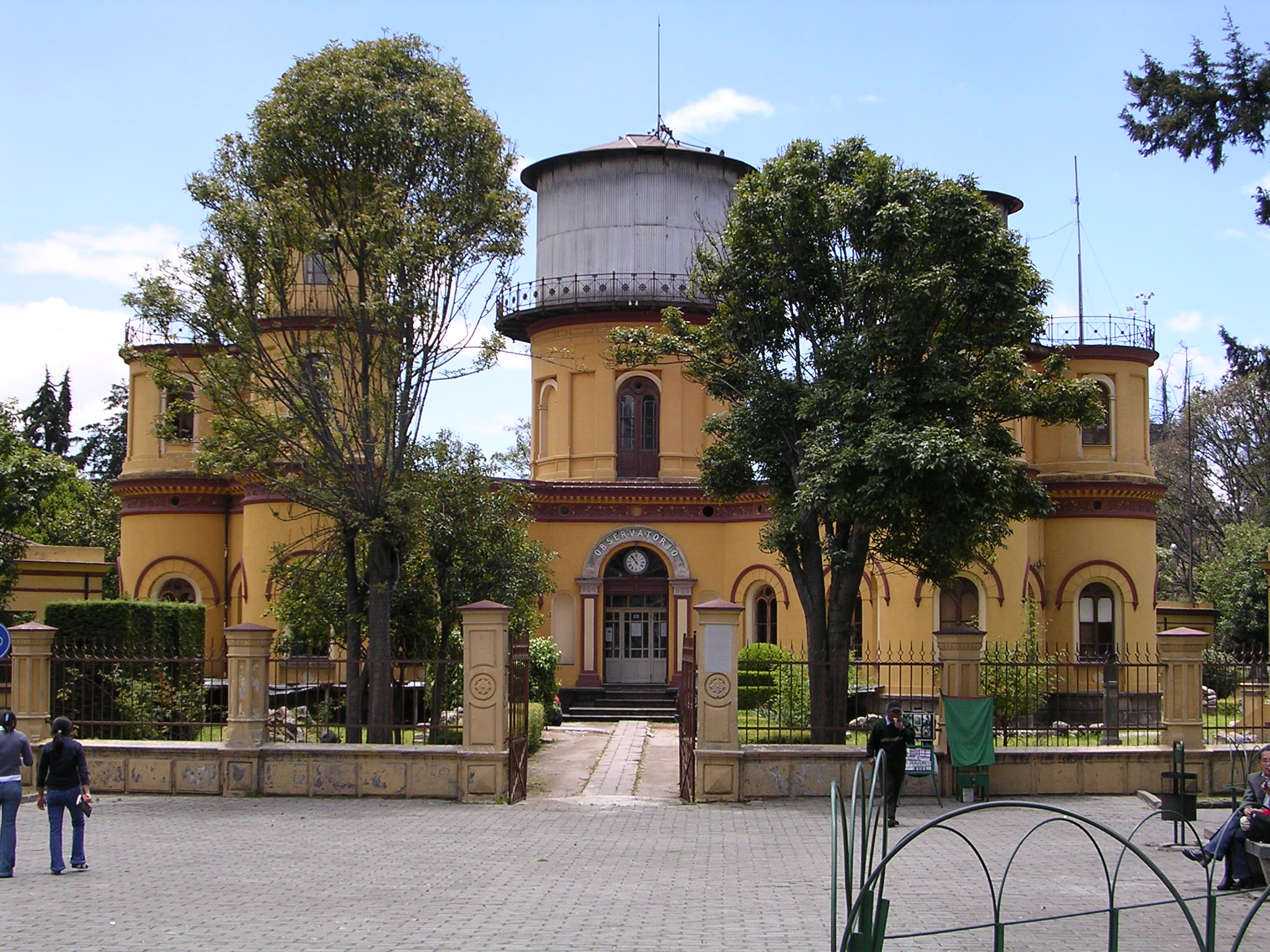La Alameda Park, Quito on:
[Wikipedia]
[Google]
[Amazon]
La Alameda Park is a park in 
 The Quito Astronomical Observatory () is a
The Quito Astronomical Observatory () is a
La Alameda metro station (Quito), La Alameda metro station is located at the southern edge of the park.
File:Antique Telescope at the Quito Astronomical Observatory 002.JPG
The Quito Astronomical Observatory () is a
Quito
Quito (; ), officially San Francisco de Quito, is the capital city, capital and second-largest city of Ecuador, with an estimated population of 2.8 million in its metropolitan area. It is also the capital of the province of Pichincha Province, P ...
.
This park is shaped like a triangle
A triangle is a polygon with three corners and three sides, one of the basic shapes in geometry. The corners, also called ''vertices'', are zero-dimensional points while the sides connecting them, also called ''edges'', are one-dimension ...
bounded by the streets Gran Colombia, Sodiro and 10 de Agosto. It is the oldest park in the city, its composition dates from 1596 with an area of 6.3 hectares. The park is also known as 'Chuquihuada'.
The park houses the "Churo," one of the oldest towns in the area, dating back to colonial times. The name "churo" refers to the shape of a snail.
Inside of this park was established the Quito Astronomical Observatory in 1864, the first astronomical observatory in South America. At the time of the construction it was the most gifted of South America
South America is a continent entirely in the Western Hemisphere and mostly in the Southern Hemisphere, with a considerably smaller portion in the Northern Hemisphere. It can also be described as the southern Subregion#Americas, subregion o ...
and still has the instrumentation
Instrumentation is a collective term for measuring instruments, used for indicating, measuring, and recording physical quantities. It is also a field of study about the art and science about making measurement instruments, involving the related ...
of the time. The park is filled with monuments. Some of the more famous among these are the sculpture built in honor of the French Geodesic Mission
The French Geodesic Mission to the Equator (), also called the French Geodesic Mission to Peru and the Spanish-French Geodesic Mission, was an 18th-century expedition to what is now Ecuador carried out for the purpose of performing an arc measu ...
and to Bolivar.
The Alameda Park is a true tradition of Quito, with its natural lagoon
A lagoon is a shallow body of water separated from a larger body of water by a narrow landform, such as reefs, barrier islands, barrier peninsulas, or isthmuses. Lagoons are commonly divided into ''coastal lagoons'' (or ''barrier lagoons'') an ...
becomes a place of relaxation for the inhabitants of the city. The park keeps inside trees that have stood the time, we can find palm tree
The Arecaceae () is a family of perennial, flowering plants in the monocot order Arecales. Their growth form can be climbers, shrubs, tree-like and stemless plants, all commonly known as palms. Those having a tree-like form are colloquially c ...
s, acacia
''Acacia'', commonly known as wattles or acacias, is a genus of about of shrubs and trees in the subfamily Mimosoideae of the pea family Fabaceae. Initially, it comprised a group of plant species native to Africa, South America, and Austral ...
s, redwood
Sequoioideae, commonly referred to as redwoods, is a subfamily of Pinophyta, coniferous trees within the family (biology), family Cupressaceae, that range in the Northern Hemisphere, northern hemisphere. It includes the List of superlative tree ...
s, toct, cedar
Cedar may refer to:
Trees and plants
*''Cedrus'', common English name cedar, an Old-World genus of coniferous trees in the plant family Pinaceae
* Cedar (plant), a list of trees and plants known as cedar
Places United States
* Cedar, Arizona
...
and ash. The oldest tree of Alameda is a 120 years old macrocarpa cypress
Cypress is a common name for various coniferous trees or shrubs from the ''Cupressus'' genus of the '' Cupressaceae'' family, typically found in temperate climates and subtropical regions of Asia, Europe, and North America.
The word ''cypress'' ...
.
In 1963, The Government of Ecuador transferred title of the Observatory to the National Polytechnic School.
One of the oldest observatories in South America
South America is a continent entirely in the Western Hemisphere and mostly in the Southern Hemisphere, with a considerably smaller portion in the Northern Hemisphere. It can also be described as the southern Subregion#Americas, subregion o ...
is the Quito Astronomical Observatory
The Quito Astronomical Observatory () is a research institute of EPN, the National Polytechnic School in Quito, Ecuador. Its major research fields are astronomy and atmospheric physics.
The Quito Astronomical Observatory is one of the oldest ob ...
.
and located 12 minutes south of the Equator
The equator is the circle of latitude that divides Earth into the Northern Hemisphere, Northern and Southern Hemisphere, Southern Hemispheres of Earth, hemispheres. It is an imaginary line located at 0 degrees latitude, about in circumferen ...
in Quito, Ecuador. The Quito Astronomical Observatory is the National Observatory of Ecuador and is located in the Historic Center of Quito and is managed by the EPN.

research institute
A research institute, research centre, or research organization is an establishment founded for doing research. Research institutes may specialize in basic research or may be oriented to applied research. Although the term often implies natural ...
of EPN, the National Polytechnic School
The National Polytechnic School ( Spanish: ''Escuela Politécnica Nacional''), also known as EPN, is a public university in Quito, Ecuador. The campus, named after José Rubén Orellana, is located in the east-central part of Quito. It occupies ...
in Quito
Quito (; ), officially San Francisco de Quito, is the capital city, capital and second-largest city of Ecuador, with an estimated population of 2.8 million in its metropolitan area. It is also the capital of the province of Pichincha Province, P ...
, Ecuador
Ecuador, officially the Republic of Ecuador, is a country in northwestern South America, bordered by Colombia on the north, Peru on the east and south, and the Pacific Ocean on the west. It also includes the Galápagos Province which contain ...
. Its major research fields are astronomy
Astronomy is a natural science that studies celestial objects and the phenomena that occur in the cosmos. It uses mathematics, physics, and chemistry in order to explain their origin and their overall evolution. Objects of interest includ ...
and atmospheric physics
Within the atmospheric sciences, atmospheric physics is the application of physics to the study of the atmosphere. Atmospheric physicists attempt to model Earth's atmosphere and the atmospheres of the other planets using fluid flow equations, rad ...
br>La Alameda metro station (Quito), La Alameda metro station is located at the southern edge of the park.
Activities and services at the Quito Astronomical Observatory at La Alameda Park
One of the Oldest Observatories in South America is the Quito Astronomical Observatory. Perfect for tourists and a short drive to all the hotels, The Quito Astronomical Observatory has been perfectly restored and is open for tourists. The activities and services currently provided by the OAQ are: * Night observations by telescopes * Museumresearch institute
A research institute, research centre, or research organization is an establishment founded for doing research. Research institutes may specialize in basic research or may be oriented to applied research. Although the term often implies natural ...
of EPN, the National Polytechnic School
The National Polytechnic School ( Spanish: ''Escuela Politécnica Nacional''), also known as EPN, is a public university in Quito, Ecuador. The campus, named after José Rubén Orellana, is located in the east-central part of Quito. It occupies ...
in Quito
Quito (; ), officially San Francisco de Quito, is the capital city, capital and second-largest city of Ecuador, with an estimated population of 2.8 million in its metropolitan area. It is also the capital of the province of Pichincha Province, P ...
, Ecuador
Ecuador, officially the Republic of Ecuador, is a country in northwestern South America, bordered by Colombia on the north, Peru on the east and south, and the Pacific Ocean on the west. It also includes the Galápagos Province which contain ...
. Its major research fields are astronomy
Astronomy is a natural science that studies celestial objects and the phenomena that occur in the cosmos. It uses mathematics, physics, and chemistry in order to explain their origin and their overall evolution. Objects of interest includ ...
and atmospheric physics
Within the atmospheric sciences, atmospheric physics is the application of physics to the study of the atmosphere. Atmospheric physicists attempt to model Earth's atmosphere and the atmospheres of the other planets using fluid flow equations, rad ...
.References
{{coord, 0.2149, S, 78.5026, W, source:wikidata, display=title Parks in Quito 1596 establishments in South America